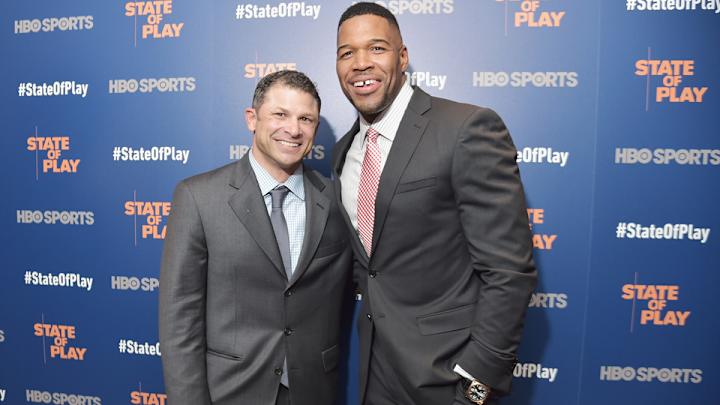HBO’s 'State of Play' explores the struggles of retired NFL players

The career of an NFL player is unlike any other: the fame, the glory, the thrill and the success. When a player steps out on the field, he has a chance to become a hero to the 70,000 cheering people in the stands and the millions more watching at home. But in a few short years, that could all end. And then what?
It’s the question that Peter Berg, executive producer of Friday Night Lights, explores in the newest episode of the HBO Sports documentary series, State of Play.
State of Play debuted last December with “Trophy Kids,” an episode chronicling the pressures young athletes face from their parents. It returns this month with a new four-episode installment, beginning with the premiere of “Happiness” on Tuesday, Nov. 18. Berg, in partnership with former New York Giants player Michael Strahan, turns to the science of happiness to explain the experiences of three retired NFL greats: Wayne Chrebet, Tiki Barber and Brett Favre. Though they all took different paths to retirement, they faced similar challenges when coping with the loss of the game.
New York Jets wide receiver Wayne Chrebet saw his career end abruptly after he suffered a concussion in November 2005 against the San Diego Chargers. Now 41-years-old, Chrebet was later diagnosed with post-concussion syndrome and went through a rough patch for years. Hoping to avoid that fate, New York Giants running back Tiki Barber took time to plan out his post-football life before his retirement in 2007. Despite the preparation, his stint as a broadcaster with NBC was described by Strahan as “one of the quickest crash and burn careers we’ve seen.” Quarterback Brett Favre retired, came back, then finally retired for good in 2011 and after football, he wanted to “find a hole and climb in it.”
Meet cheerleader Kelly Bennion: smart, sexy and highly educated
The episode takes a deeper look into the post-NFL life and peels back its many layers by consulting experts who can explain the science behind it. Personal accounts of success and struggle are interspersed with explanations of how flow theory, social rejection and positive psychology contribute to both the thrill of the game and the inevitable withdrawal when it’s over.
From the players’ interviews, it’s clear that whether they think they’re ready for retirement or not, no professional player can fully prepare for the loss.
In one scene, as the camera captures Jets memorabilia and framed jerseys in Chrebet’s home, his wife Amy describes how they never went back for his things after his last game. It was easier to have everything shipped back, where the boxes of reminders stayed unopened by Chrebet for a long while. He was thrust back into a “normal” life, but it was without structure, routine, fans, and hardest of all, his teammates.
The team -- it’s the aspect of football all the interviewed players on the show say they miss the most. Naturally, it’s also how they regain their balance. State of Play details the new careers and teams of each of the former NFL stars. From Chrebet's MRI scan and doctor visits, to Barber straining to lift weights in his attempt to return to the NFL and Favre cheering from the sidelines at a high school football game, the show reintroduces the former heroes in new and more personal ways.
The documentary is followed by a roundtable with positive psychologist Shawn Achor, former Navy SEAL Marcus Luttrell and Strahan, who ironically had one of the most successful post-career transitions in recent years. By the end of the episode, the audience gets an answer to the question that Berg and Strahan opened with: “Can you ever find your happiness outside of football?” The answer is yes. But not without taking a few hard hits first.
